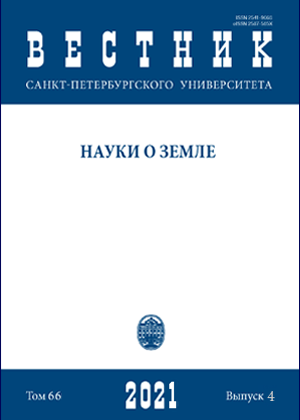Monitoring of stable isotopes (δ2H, δ18O) in precipitations of Moscow city (Russia): comparison for 2005–2014 and 1970–1979 periods
DOI:
https://doi.org/10.21638/spbu07.2021.405Abstract
The isotopic composition of oxygen (δ18O) and hydrogen (δ2H) of atmospheric precipitation in Moscow in 2005–2014 was studied by sampling single precipitations (a total of 842 measurements after rejection of unreliable samples). A comparison is made with similar studies carried out by VSEGINGEO and IVP RAS for the IAEA-WMO GNIP network in 1969–1979, when monthly average samples were taken by the accumulation method (61 pair determinations of deuterium and oxygen-18, mainly in 1975–1979). The 2005–2015 series is reduced to a similar form for the 1969–1979 series, recalculated through the data on the volume of precipitation at the nearest meteorological station. It was found that in the last decade there has been a significant change in the equation of the local line of meteoric waters, which for the first period had the form δ2H = 6.09×δ18O – 23.0 ‰ (R2 = 0.87), and is currently described by the relation δ2H = 6.93×δ18O – 11.3 ‰ (R2 = 0.944). There is also a decrease in depletion of the average values of δ2H and δ18O, compared with the first observation period, which apparently reflects the course of climatic changes. At the same time, within each of the periods, a negative (albeit relatively small) slope of the line of approximation of chronological data is noted. Deuterium excess naturally changes seasonally, taking negative values in summer, primarily due to non-equilibrium fractionation during evaporation. In 2005–2014, the temperature dependence of the isotopic composition of precipitation changed significantly in comparison with 1969–1979, which makes it impossible to reconstruct the composition of precipitation in the past from meteorological observations.
Keywords:
atmospheric precipitation, isotopic composition of oxygen and hydrogen, climate
Downloads
References
Brezgunov, V. S., Esikov, A. D. and Yakimova, T. V. (1987). Distribution of the mean annual concentrations of oxygen-18 in precipitation of the European part of the USSR. Materials of meteorological investigations, 12, 54-58. (In Russian)
Chizhova, Yu. N., Eremina, I. D., Budantseva, N. A., Surkova, G. V. and Vasil’chuk, Yu. K. (2017). Concentration of 18O in Precipitation over Moscow in 2014.Russian Meteorology and Hydrology, 42 (1), 54-63.
Dansgaard, W. (1964). Stable isotopes in precipitation. Tellus, 19, 435-463.
Ferronsky, V. I. and Polyakov, V. A. (2012). Isotopes of the Earth’s Hydrosphere. Dordrecht: Springer.
Hager, B. and Foelsche, U. (2015). Stable isotope composition of precipitation in Austria. Austrian Journal of Earth Sciences, 108 (2), 2-13. https://doi.org/10.17738/ajes.2015.0012
iaea.org. (n. d.). Official Web Site of the IAEA. [online] Available at: http://iaea.org [Accessed 28 Dec. 2021].
Mook, W. G. (2001). Environmental isotopes in the hydrological cycle. Principles and applications. Paris: UNESCO, I.
Rolph, G. D. (2016). Real-time environmental applications and display system (ready). [online] Available at: http://www.ready.noaa.gov [Accessed 30 Jan. 2021].
Stein, A. F., Draxler, R. R., Rolph, G. D., Stunder, B. J. B., Cohen, M. D. and Ngan, F. (2015). NOAA’s HYSPLIT atmospheric transport and dispersion modeling system. Bull. Amer. Meteor. Soc., 96, 2059-2077. http://dx.doi.org/10.1175/bams-d-14-00110.1
Vasilchuk, Yu. K. (2014). New Data on the Tendency and Causes of Deuterium Excess Variations during One Snowfall. Doklady Earth Sciences, 459 (1), 1400-1402. https://doi.org/10.1134/S1028334X14110105
West, J. B., Bowen, G. J., Dawson, T. E. and Tu, K. P. (eds) (2010). ISOSCAPES. Understanding movement, pattern, and process on earth through isotope mapping. Dordrecht, Heidelberg, London, New York: Springer. https://doi.org/10.1007/978-90-481-3354-3
Downloads
Published
How to Cite
Issue
Section
License
Articles of "Vestnik of Saint Petersburg University. Earth Sciences" are open access distributed under the terms of the License Agreement with Saint Petersburg State University, which permits to the authors unrestricted distribution and self-archiving free of charge.






